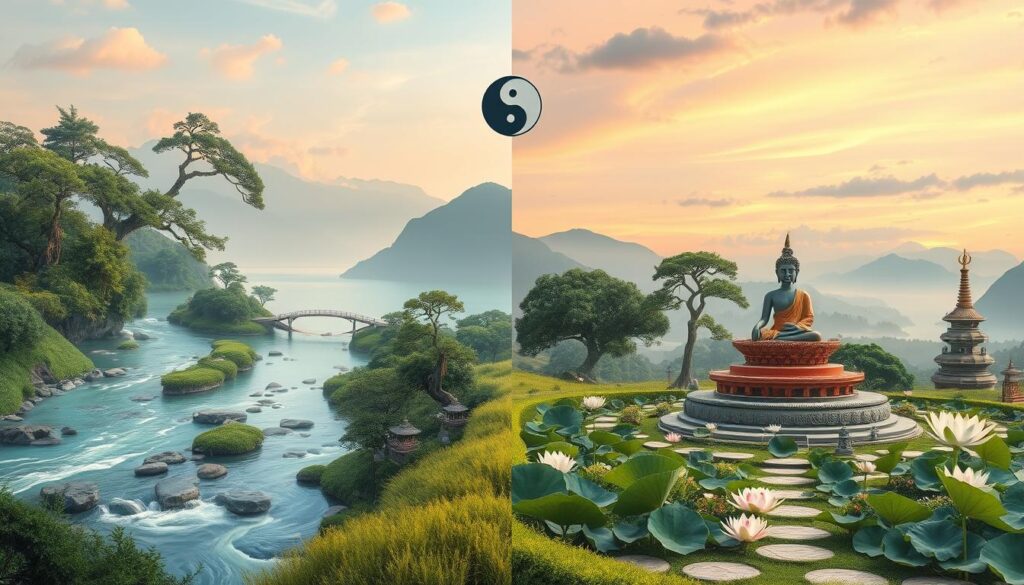“The Tao that can be told is not the eternal Tao. The name that can be named is not the eternal name.” – Lao Tzu, Founder of Taoism
Exploring Eastern philosophies, you’ll find the big differences between Taoism and Buddhism. Both teach mindfulness and inner peace. But, they have different views on life and how to find enlightenment.
Key Takeaways
- Taoism values spontaneity, simplicity, and living in harmony with nature. Buddhism, on the other hand, follows the Eightfold Path and the Four Noble Truths.
- Taoists celebrate individuality and self-expression. Buddhists, however, teach letting go of the ego and embracing emptiness.
- Taoists deal with suffering by aligning with the Tao and being adaptable. Buddhists use mindfulness and understanding interconnectedness to overcome suffering.
- Taoism promotes living in harmony with nature. Buddhism focuses on karma and mindful actions leading to good outcomes.
- Both traditions offer valuable insights. Practitioners can gain from combining their ideas and practices.
Understanding the Origins and Historical Context
Buddhism and Taoism are two key Eastern philosophies that have deeply influenced cultures for ages. To grasp their significance, it’s vital to know their beginnings and the historical settings that birthed them.
Birth of Buddhism in Ancient India
Siddhartha Gautama, known as the Buddha, started Buddhism in ancient India around the 5th century BCE. His deep spiritual awakening and teachings on suffering, rebirth, and enlightenment set the stage for a global religious movement.
Emergence of Taoism in China
Lao Tzu, the founder of Taoism, lived in China from the 5th-6th century BCE. Taoism emerged in a time of turmoil, focusing on harmony, balance, and the natural order. It has profoundly shaped Chinese culture and beyond.
Historical Timeline and Development
Buddhism and Taoism both grew and evolved over the centuries. Buddhism spread after Siddhartha’s death, reaching India, China, and Southeast Asia. Taoism flourished during China’s Tang dynasty, influencing art, religion, and lifestyle in Asia.
Though Buddhism and Taoism coexisted peacefully in some areas, they faced persecution and competition. This complex history shows the dynamic relationship between these two Eastern philosophies and their lasting global impact.
Foundational Beliefs and Core Philosophies
Taoism and Buddhism are two major spiritual paths in the East. Taoism started around 550 B.C. in China and has 20-30 million followers today. Buddhism began in the sixth century B.C. in India and has about 500 million followers worldwide, making it the fourth-largest religion.
Taoism focuses on the Tao (the Way), a key idea about living in harmony with life. Taoists believe in eternal souls and rebirth until they reach the Tao and become immortal. Buddhists, however, aim to end reincarnation by living morally and letting go of worldly desires.
Buddhists don’t believe in a god and seek truth through self-discovery. Taoists, on the other hand, believe in deities and aim for life balance. Taoists see relationships as a mix of Yin and Yang, supporting marriage to balance life forces. Buddhists accept illnesses and use meditation for freedom, unlike Taoists who believe in Tai Chi and Chi energy for health.
Both traditions value the connection of all things and living ethically. Buddhists focus on karma, while Taoists stress balance and peaceful living. Their shared growth has enriched Eastern philosophy and culture.
“The Tao that can be told is not the eternal Tao. The name that can be named is not the eternal name.” – Lao Tzu, Tao Te Ching
In summary, Taoism and Buddhism offer unique yet similar views on life and enlightenment. Understanding these paths can deepen our respect for human spirituality’s diversity and richness.
Key Differences between Taoism and Buddhism
Taoism and Buddhism are two major Eastern philosophies. They share some similarities but also have key differences. These differences are in their views on human nature, suffering, enlightenment, and the afterlife.
Views on Human Nature and Suffering
Buddhism sees ignorance as the root of human suffering. It believes that by overcoming this ignorance, one can reach nirvana. This is a state of complete peace and liberation.
Taoism, on the other hand, believes that the natural order of the universe, known as the Tao, holds the key. Taoists aim to align themselves with the Tao. They do not seek to transcend the physical world.
Approaches to Enlightenment
The Buddhist path to enlightenment focuses on mindfulness, detachment, and wisdom. Buddhists believe in observing the present moment with clarity. They let go of attachment to achieve a deeper understanding of reality.
Taoists, however, focus on cultivating qi (vital energy). They aim to live in harmony with the natural world. This helps them attain a state of balance and inner peace.
Concept of Afterlife and Reincarnation
Buddhism’s concept of samsara, the cycle of rebirth, is central. Buddhists believe that the ultimate goal is to break free from this cycle. They aim to achieve nirvana.
Taoists, in contrast, believe in the eternal nature of the soul. They believe that the soul will eventually become one with the Tao. Taoists do not focus on reincarnation but on achieving immortality through spiritual practices.

While Taoism and Buddhism share some foundational principles, their distinct views have shaped two unique traditions. These traditions continue to captivate and inspire people worldwide.
Sacred Texts and Religious Scriptures
Dive into the deep wisdom of Buddhism and Taoism through their sacred texts. The Buddhist tradition is based on the Tripitaka, a huge collection of teachings. It includes the Discourses, the Discipline, and the Commentaries. These texts guide followers towards enlightenment.
Early Buddhist scriptures like the Gandhara texts also shed light on the religion’s early days.
In Taoism, the Daozang is a collection of over 1,400 texts, divided into three parts. At its core is the Tao Te Ching, said to be written by Lao Tzu. It talks about the Dao and wu wei (non-action).
The Zhuang Zi and the I Ching (Book of Changes) also highlight Taoist beliefs. They focus on living in harmony, simplicity, and following life’s natural flow.
| Buddhist Scriptures | Taoist Scriptures |
|---|---|
| Tripitaka (Discourses, Discipline, Commentaries) | Daozang (Collection of over 1,400 texts) |
| Gandhara texts (Early Buddhist scriptures) | Tao Te Ching (Attributed to Lao Tzu) |
| Prajnaparamita Sutras (Mahayana Buddhism) | Zhuang Zi |
| Lotus Sutra (Mahayana Buddhism) | I Ching (Book of Changes) |
These texts are the heart of Buddhism and Taoism. They provide deep insights into existence, enlightenment, and living in harmony with the universe or the Buddha’s teachings.
“The scripture is a lamp to dispel the darkness of ignorance, and a key to unlock the door of liberation.” – Buddhist Proverb
Spiritual Practices and Meditation Techniques
Taoism and Buddhism both value spiritual practices and meditation. Each has its own way to help people grow spiritually and find enlightenment. Let’s look at what makes these paths special.
Buddhist Meditation and Mindfulness
Buddhist meditation centers on Vipassana, or insight meditation. It begins with focusing on the breath to stay in the present. This helps people notice their body’s feelings without judgment, following Buddhist teachings.
Deep thinking is key in Vipassana. It leads to big changes in how we see ourselves. A silent guide helps keep the focus sharp during meditation.
Taoist Internal Alchemy and Qi Cultivation
Taoism focuses on working with life energy, called Qi. Taoist meditation uses inner alchemy to connect with natural flows. It’s about finding balance between opposing forces, like Yin and Yang.
These meditations also use concentration and mindfulness. They help people feel in sync with the universe.
Role of Ritual and Ceremony
Rituals and ceremonies are important in both Taoism and Buddhism. They help deepen the connection to the divine. They also bring people together, helping everyone grow spiritually.
Chanting and elaborate rituals are used. Symbolic gestures and sacred places help deepen awareness and respect for the universe’s mysteries.
“The ultimate goal of both Buddhist and Taoist meditation is to achieve a state of inner peace, harmony, and alignment with the universal Tao or Buddha-nature.”
Views on Deity and Divine Nature
Taoism and Buddhism have different views on deity and divine nature. Buddhism does not believe in a creator God. Instead, it focuses on the impermanence of all things and the lack of a permanent self.
Taoism, however, sees the divine as the Tao. This is the ultimate reality that is beyond human understanding. Taoists believe in living in harmony with the natural flow of the Tao.
Both traditions acknowledge the existence of gods or celestial beings. But they see these beings differently. In Buddhism, they are trapped in the cycle of samsara, rebirth and suffering. They are not the ultimate source of enlightenment.
Taoists, though, see these beings as parts of the Tao. They act as intermediaries between humans and the divine. Taoists focus on understanding the Tao and the natural world, not on worshiping these beings.
In summary, Taoism and Buddhism both value the divine and the connection of all things. Yet, their views on deity and divine nature are quite different. This shows the richness and complexity of Eastern spiritual traditions, offering a deep understanding of our place in the world.

Role of Teachers and Religious Authority
In both the Buddhist and Taoist traditions, teachers and religious authority are key. Let’s look at how they work in each tradition.
Buddhist Sangha and Monastic Life
The Buddhist Sangha includes bhikkhus (male monks) and bhikkhunis (female nuns). They are crucial for keeping and sharing the Buddha’s teachings. Monastics live a life of spiritual practice, study, and service, following the precepts.
They serve as an example for the lay community. Monastic life in Buddhism is marked by discipline, community, and a focus on meditation and mindfulness.
Taoist Masters and Lineage Systems
In Taoism, Taoist masters (daoshis) and lineage systems are very important. Taoist knowledge and practices are passed down through generations. Each master teaches their disciples, sharing their understanding and techniques.
Taoist masters are respected for their deep Tao knowledge and spiritual mastery. They guide students on the path to enlightenment. Taoism’s approach to spiritual authority is more flexible, with practitioners often following multiple teachers and lineages.
| Buddhist Sangha | Taoist Masters |
|---|---|
| Composed of bhikkhus (male monks) and bhikkhunis (female nuns) | Taoist masters (daoshis) and lineage systems |
| Focused on preserving and transmitting the Buddha’s teachings | Passing down Taoist knowledge and practices through lineages |
| Monastic life characterized by discipline, community living, and meditation | Flexible approach to spiritual authority, with practitioners following multiple teachers and lineages |
Both the buddhist sangha and taoist masters are vital in their traditions. They guide practitioners and keep ancient wisdom alive.
Influence on Eastern Philosophy and Culture
Taoism and Buddhism have deeply influenced Eastern philosophy and culture. These ancient philosophies have shaped art, literature, and social norms in countries like China, Japan, Korea, and Vietnam for centuries. Their mix with other Eastern traditions, like Confucianism, has created a rich cultural impact that still affects us today.
Eastern culture is filled with ideas from Taoism and Buddhism, such as mindfulness and harmony with nature. These ideas have changed how people live and interact. They have also influenced spiritual and religious practices.
For instance, Taoist ideas about living in the moment and finding joy in simplicity have inspired Chinese arts. Buddhist teachings on suffering and enlightenment have shaped Eastern literature, music, and architecture.
These philosophies have also shaped social norms and ethics. Confucian values like respect for elders and family harmony have blended with Taoism and Buddhism in East Asia. This blend has created a unique cultural and ethical framework.
As the world gets more connected, Eastern philosophies and cultural impact are growing. They inspire new art, wellness practices, and ways to improve personal and societal well-being.
| Philosophy | Key Influence | Examples |
|---|---|---|
| Taoism | Art, literature, medicine, martial arts | Traditional Chinese painting, calligraphy, poetry, Tai Chi, Traditional Chinese Medicine |
| Buddhism | Architecture, music, philosophy, social norms | Buddhist temples, gardens, meditation practices, ethical frameworks |
| Confucianism | Social structures, ethics, education | Family structure, respect for elders, civil service examination system |
Modern Practice and Global Impact
Today, ancient philosophies like Taoism and Western Buddhism are more relevant than ever. They have spread beyond their traditional roots, touching many areas of modern life. These teachings influence how we grow personally and interact with nature.
Contemporary Applications
Modern taoism and western buddhism are now part of our daily lives. Mindfulness meditation, for example, helps people become more aware of themselves. It also reduces stress and brings peace.
Taoist ideas of balance and harmony have shaped the holistic health movement. This movement combines Eastern and Western wellness practices. It shows how these ancient teachings can fit into our modern lives.
The focus on nature in Taoism and Buddhism has sparked a global environmental movement. People worldwide are now more aware of the need to protect our planet. This awareness has grown thanks to these philosophies.
Western Adoption and Adaptation
- The West has warmly welcomed Taoism and Buddhism, making them fit for today’s world.
- Mindfulness, like meditation and yoga, is now common. Millions practice it every day.
- Taoist ideas of balance have influenced health centers and personal growth programs. These places offer holistic approaches to well-being.
- The growing interest in Eastern philosophies has created a big market. Books, workshops, and online resources share these teachings globally.
As our world changes, Taoism and Buddhism’s wisdom stays important. They offer a calm in our fast-paced lives. By embracing these teachings, we can find peace, care for the environment, and understand ourselves better.
Harmony and Integration of Both Traditions
Exploring Taoism and Buddhism reveals a deep connection between these ancient Eastern traditions. They both value the natural world, seek inner peace, and aim to go beyond the ego. This shared focus shows their harmony and integration.
The Tang Dynasty (618-907 CE) saw a surge in cultural exchange, making Taoism and Buddhism even closer. This period showed that these traditions can blend well, sharing core values and practices.
Whether you’re drawn to Taoism’s natural flow or Buddhism’s mindfulness, both offer valuable insights. By combining their wisdom, you can grow personally and understand the world better. This approach brings harmony, peace, and a deeper connection to eastern wisdom in today’s world.
FAQ
What are the key differences between Taoism and Buddhism?
Taoism and Buddhism have different views on human nature and suffering. Buddhism sees ignorance as the root of suffering. It aims for nirvana. Taoism believes in aligning with the Tao to ease life’s hardships.
Buddhism focuses on mindfulness and detachment. Taoism emphasizes cultivating qi and living in harmony with nature. Their methods for achieving enlightenment differ.
What are the historical origins of Taoism and Buddhism?
Buddhism started around 563 BCE in ancient India with Siddhartha Gautama (the Buddha). Taoism emerged around 550 BCE in China, thanks to Lao Tzu and the Tao Te Ching. Their birthplaces greatly influenced their development and spread.
What are the foundational beliefs and core philosophies of Taoism and Buddhism?
Buddhism is based on the Four Noble Truths and the Eightfold Path. These outline a path to enlightenment through the cessation of craving and attachment. Taoism focuses on the Tao and yin and yang, emphasizing harmony with nature.
Both traditions value ethical living. But Buddhism focuses on karma, while Taoism emphasizes balance and peaceful coexistence.
What are the sacred texts and religious scriptures of Taoism and Buddhism?
Buddhism’s sacred texts include the Tripitaka and early scriptures like the Gandhara texts. Taoism’s most significant scriptures are the Daozang, a collection of 1400 texts. This includes the Tao Te Ching, Zhuang Zi, and I Ching.
What are the spiritual practices and meditation techniques in Taoism and Buddhism?
Buddhist meditation focuses on inner stillness and clarity. Taoism emphasizes internal alchemy and qi cultivation, including acupuncture and qigong. Both traditions value ritual and ceremony for spiritual development and community cohesion.
How do Taoism and Buddhism view the concept of deity and divine nature?
Buddhism rejects a personal God, with the Buddha refuting theistic arguments. Taoism sees the Tao as the ultimate reality, beyond human comprehension. Both traditions have unique views on celestial beings or gods.
Buddhism sees them as beings still bound by samsara. Taoism views them as manifestations of the Tao.
What is the role of teachers and religious authority in Taoism and Buddhism?
In Buddhism, the Sangha is crucial for preserving and transmitting teachings. Taoism has a flexible approach to spiritual authority. Taoist masters and lineage systems pass down knowledge.




























































